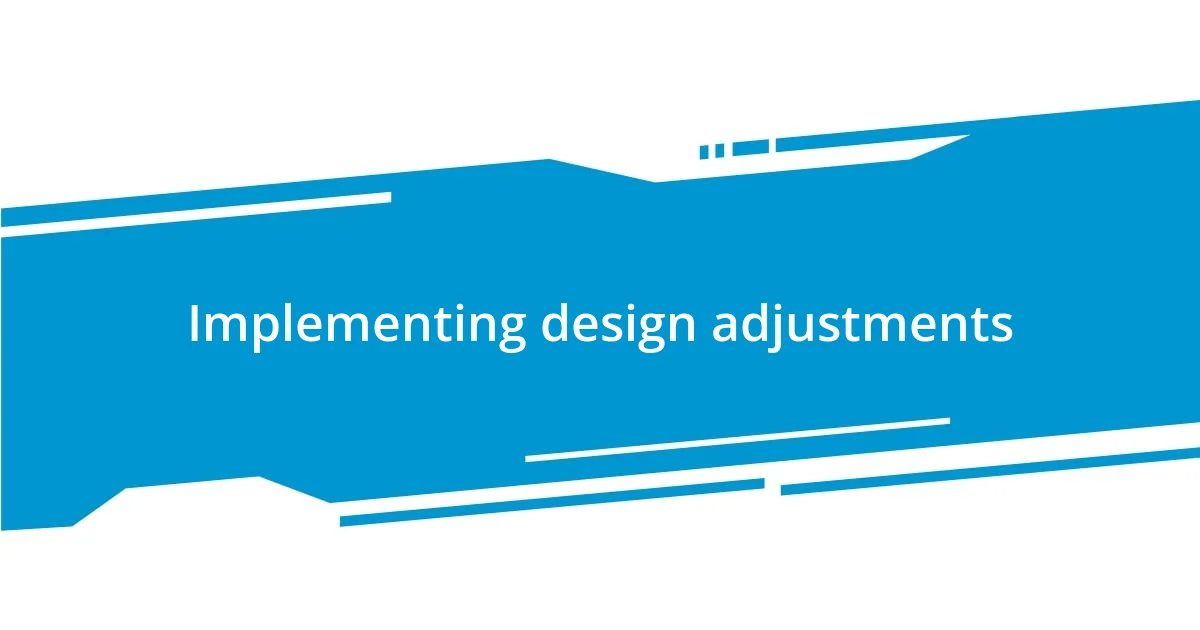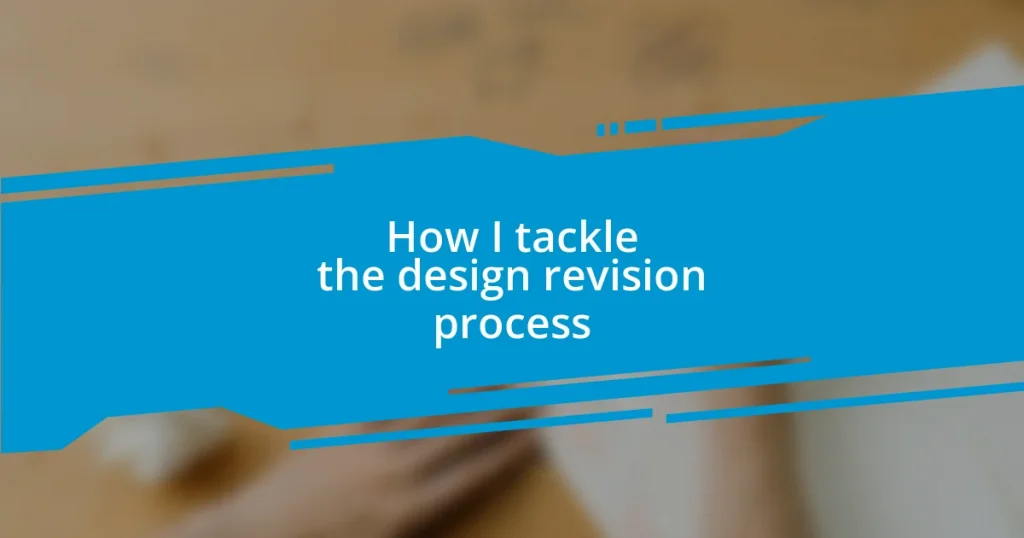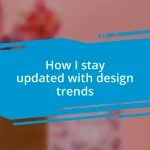Key takeaways:
- Engaging in a collaborative dialogue during the design revision process enhances the quality of feedback and insights, leading to improved outcomes.
- Implementing design adjustments should be methodical, focusing on one key change at a time while documenting the process for future reference.
- Regular communication with stakeholders fosters transparency, making them feel involved and valued, which can significantly benefit the overall design process.

Understanding design revision process
The design revision process is a critical phase that transforms initial ideas into polished final products. I remember a project where I thought I had nailed the design, only to realize, during revisions, that the colors I chose didn’t resonate with the branding. That moment taught me how crucial it is to remain open and reflective during each round of revisions.
When I embark on a design revision, I often ask myself, “What emotions does this design evoke?” This question guides me to assess not only the aesthetics but the overall message I intend to convey. For instance, I once worked on a website for a local charity and found that minor tweaks in the layout significantly improved user engagement.
Understanding the revision process means recognizing it as a collaborative dialogue, both with oneself and with clients or team members. I’ve found that inviting feedback—however daunting it may feel—creates opportunities for richer, more dynamic outcomes. As I engage with others’ perspectives, I often discover fresh insights that I’d never considered on my own.

Preparing for design revisions
Preparing for design revisions requires me to gather my thoughts and tools, creating a conducive environment for feedback and creativity. I’ve learned that having all necessary materials—including initial designs, notes, and feedback from team members—at hand helps streamline the process. There was a time I jumped into revisions without a clear idea of what to focus on, and I quickly felt overwhelmed. Now, I take a moment to breathe and set clear objectives before diving in.
Here are some strategies I find helpful for a smooth preparation phase:
- Collect and organize all feedback, making sure I understand the perspectives of everyone involved.
- Review the initial design to remind myself of the original goals and concepts.
- Set aside emotional attachments to specific design elements; it’s vital for growth.
- Create a checklist of aspects to review, like functionality, aesthetics, and user experience.
- Schedule focused revision sessions free from distractions to maintain my flow.
By shaping a clear and reflective mindset, I can approach revisions with a sense of purpose and clarity.

Gathering feedback effectively
Gathering feedback effectively is an art in itself. I find that creating an open environment where others feel comfortable sharing their thoughts is essential. When I worked on a branding project last year, I held a casual feedback session over coffee. The relaxed atmosphere prompted honest conversations and sparked ideas that I hadn’t even considered.
What I’ve discovered is that the method of gathering feedback can greatly influence the quality of insights I receive. For example, giving my team specific questions to ponder, coupled with some visual prompts, elicits more meaningful responses than simply asking for general thoughts. In one case, I presented different color palettes to the team during a brainstorming meeting. By framing the feedback request around specific choices, the dialogue became more focused and productive, resulting in a color palette that perfectly captured the brand’s essence.
Lastly, I emphasize the importance of timing when seeking feedback. After working intensively on a design, I’ve realized that allowing myself to step away—sometimes even overnight—can provide that much-needed fresh perspective. During a revision process for a client’s website, a brief hiatus gave me clarity on what needed refinement. It’s fascinating how taking a moment to pause can lead to some of the best feedback, whether it’s from myself or my collaborators.
| Feedback Gathering Method | Description |
|---|---|
| Open Environment | Create a comfortable space for honest dialogue. |
| Focused Questions | Direct queries guide the feedback process effectively. |
| Timing | Allow breaks to achieve fresh perspectives before feedback sessions. |

Prioritizing design changes
Prioritizing design changes can often feel daunting, but I’ve learned that it’s all about understanding the impact of each modification. I remember a time when I was overwhelmed with feedback; I had a long list of changes to make, but not all of them carried the same weight. By assessing which revisions would enhance user experience or align better with project goals, I was able to focus my efforts on changes that truly mattered.
To effectively prioritize, I create a matrix that compares the importance and effort required for each change. This simple tool not only clarifies my decision-making but also minimizes stress. I typically categorize changes as “high impact, low effort,” which I dive into right away, and “low impact, high effort,” which I often revisit later. It’s fascinating how this method reveals priorities and allows me to manage my time more effectively, turning chaos into organized creativity.
Sometimes, it helps to reflect on the emotional side of design changes too. When I had a designer friend who was attached to a particular layout, I gently reminded her that design is less about personal preferences and more about user needs. This perspective shift can be liberating. The thrill comes from knowing that every adjustment I prioritize will ultimately enhance the experience for the end user. So, what are you willing to let go of for the greater good of your design?

Implementing design adjustments
Implementing design adjustments requires a deliberate approach that balances creativity with practicality. I remember a project where I had to adjust a website layout after receiving feedback about navigation issues. Instead of jumping in and making several changes at once, I focused on implementing one key adjustment at a time. This allowed me to observe how each change affected the user experience, clearly highlighting both improvements and any new challenges.
I’ve found that documenting each adjustment also plays a crucial role. In one of my earlier projects, I began keeping a design journal to track the rationale behind each change and the responses to them. It helped me stay grounded in the original goals while still allowing for flexibility. This process also became a valuable reference point for future projects, aiding my growth as a designer. Reflecting on past adjustments made me realize how every small tweak contributes to a more cohesive final product.
Lastly, engaging the team in the implementation phase can foster a collaborative spirit. I distinctly recall when we integrated some suggested changes into a mobile app’s interface; inviting team members to test the adjustments with me created a sense of shared ownership. What’s more, I always ask for feedback from team members after implementation. This dialogue often reveals unexpected insights, proving that adjustments are a journey best undertaken together. Are you ready to embrace collaboration in your design process?

Communicating with stakeholders
Communicating with stakeholders is a pivotal aspect of the design revision process. I recall a particularly challenging project where the client had a distinct vision that didn’t align with our user research findings. Instead of sidestepping the issue, I initiated an open dialogue. I shared user feedback and analytics, translating data into visuals that resonated with their expectations. It was enlightening to witness their concerns transform into a collaborative conversation about how we could bridge their vision with user needs.
The emotional stakes can run high in these discussions. I vividly remember a meeting where tensions were palpable; everyone was passionate about their ideas, but it threatened to devolve into a standoff. To ease the atmosphere, I acknowledged everyone’s perspectives and encouraged candid exchanges. By framing it as a problem to solve together rather than a debate to win, we were able to foster an atmosphere of mutual respect and creativity. Have you ever experienced a similar situation, where empathy played a key role in uniting differing views?
Maintaining open lines of communication throughout the process is also crucial. I make it a point to regularly update stakeholders with progress reports, highlighting wins and areas needing attention. This transparency ensures that everyone feels involved and valued. I once had a client who expressed gratitude for these updates, mentioning how they felt more connected to the project. Their positive feedback reaffirmed my belief that when stakeholders are informed, they become more invested. Isn’t it fascinating how a little communication can pave the way for a more collaborative and productive design process?

Assessing final design outcomes
Assessing final design outcomes is often a mix of excitement and anxiety. I distinctly remember unveiling a completed project to a client, only to notice a fleeting moment of hesitation in their eyes. Instead of letting it fester, I encouraged them to share their initial thoughts openly. That candid exchange revealed some very subtle aspects of the design that we needed to refine, which ultimately elevated the outcome.
To gauge the effectiveness of a design, I find it invaluable to go beyond personal impressions. In a past project for an e-commerce site, I used user testing sessions to observe real interactions. Watching users engage with the product firsthand gave me insights that spreadsheets and reports simply couldn’t capture. Have you tried conducting similar sessions? I can’t stress enough how watching someone use your design can highlight areas that need improvement much clearer than any feedback form.
A final design assessment also involves measuring its success against original goals. I recall a brand redesign where we aimed to increase user engagement by 30%. After implementing the design, we started tracking the impact using analytics tools. When we hit that target in a shorter timeframe than expected, it felt invigorating! Isn’t it rewarding when your design not only meets but exceeds the initial expectations? This process of reflection and measurement not only validates your work but also fuels your passion for continual growth as a designer.














